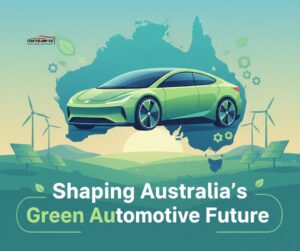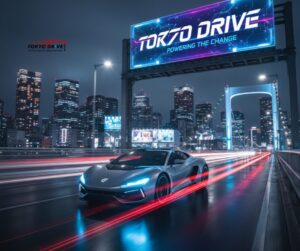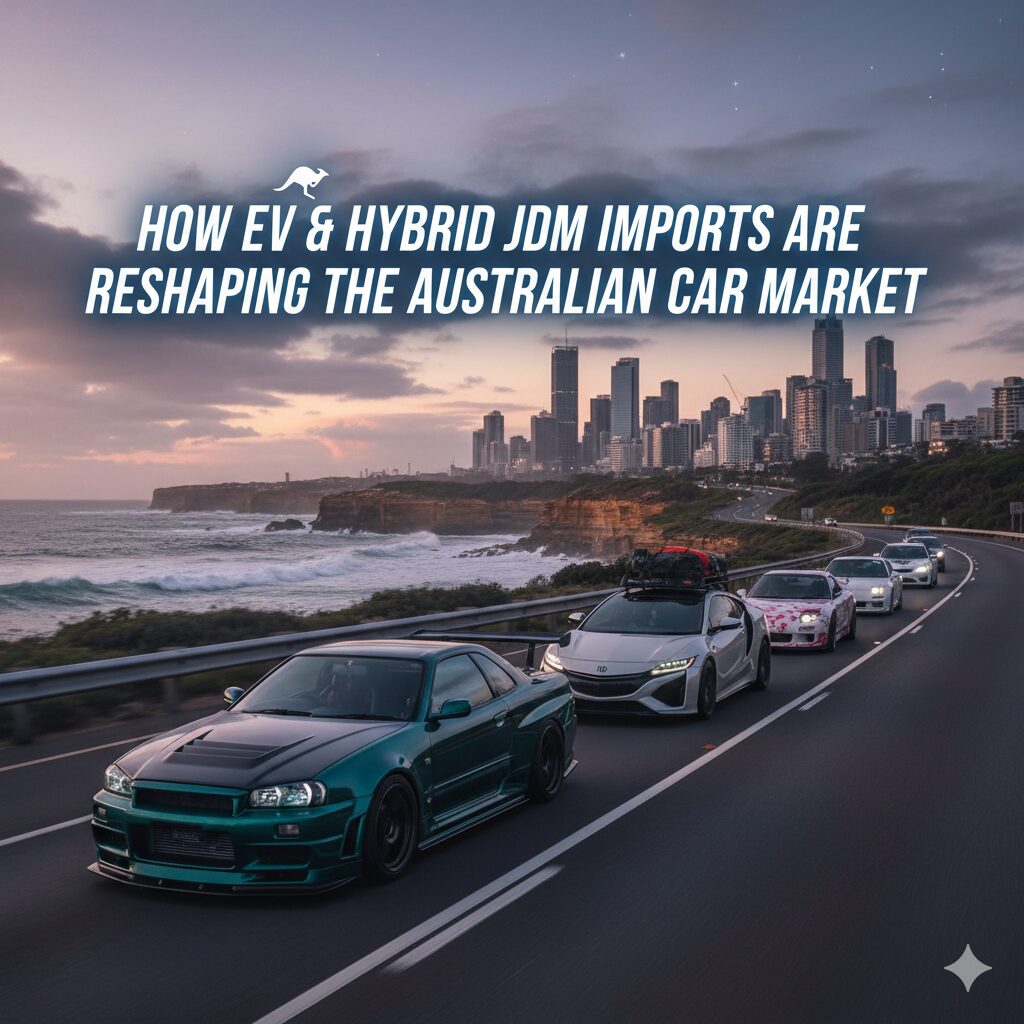The automotive world is changing fast—and Australia is no exception. As fuel prices rise and environmental awareness grows, electric vehicles (EVs) and hybrid cars are quickly becoming the future of Australian roads. But what’s truly transforming the landscape is the influx of JDM (Japanese Domestic Market) imports—affordable, reliable, and packed with advanced technology.
From Toyota Prius hybrids to Nissan Leaf EVs, Japanese imports are no longer just a niche interest for enthusiasts—they’re redefining what Australians drive, how much they spend, and how they think about sustainability.
Let’s explore how EV and hybrid JDM imports are reshaping the Australian car market in 2025, and why more Australians are turning to Japan for their next eco-friendly vehicle.
1. A Growing Demand for Affordable Green Cars
Australia’s automotive industry has seen a clear shift toward sustainability, but one of the biggest barriers for buyers has been price. Brand-new electric and hybrid models from European or American manufacturers often come with hefty price tags, making them inaccessible for many everyday drivers.
That’s where JDM imports fill the gap.
Japanese carmakers have been leading the EV and hybrid revolution for over two decades. Their domestic models—built for Japan’s strict emission standards and urban environments—offer cutting-edge efficiency at a fraction of the cost.
Popular imports like the Toyota Aqua (Prius C), Honda Fit Hybrid, and Nissan Leaf ZE1 give Australian buyers the chance to own reliable, low-emission vehicles without breaking the bank.
Key Advantage:
-
JDM EVs and hybrids cost up to 30–50% less than equivalent Australian-market models.
-
Perfect for eco-conscious buyers on a budget.

2. Proven Reliability & Engineering Excellence
Japan’s automotive industry is world-renowned for quality, durability, and innovation. The same holds true for its EV and hybrid models. Vehicles such as the Toyota Prius Alpha and Honda Insight have been tested for years in Japan’s dense traffic and varying climates—making them perfect for Australian conditions.
Moreover, Japanese hybrids are engineered for long-term battery performance and low maintenance costs. Many imported EVs feature regenerative braking systems and self-charging technologies that extend battery life while reducing fuel dependency.
Why Australians Love JDM Hybrids:
-
Exceptional fuel economy (some averaging over 25 km/l).
-
Low emissions and maintenance costs.
-
Proven reliability over millions of kilometers globally.
3. Expanding Choices Beyond Local Dealerships
Traditionally, Australians were limited to models officially imported by manufacturers and sold through local dealerships. However, through trusted JDM importers like Tokyo Drive, car enthusiasts now have access to a much wider range of eco-friendly vehicles—many of which aren’t available in local showrooms.
For example:
-
The Toyota Crown Hybrid combines luxury with sustainability.
-
The Honda Freed Hybrid offers a spacious family-friendly layout.
-
The Nissan Note e-Power delivers electric driving performance without plug-in charging.
This diversity means Australian drivers no longer have to compromise on style, performance, or price when choosing an environmentally conscious vehicle.
Impact on the Market:
-
Broader selection of affordable EVs and hybrids.
-
Increased competition pushing local prices down.
-
Faster adoption of sustainable mobility solutions.
4. Shaping Australia’s Green Automotive Future
Government incentives and stricter emission standards are further accelerating the shift toward low-emission vehicles. Several Australian states now offer rebates, tax benefits, and reduced registration fees for EV and hybrid car owners.
As more JDM EVs enter the market, Australians are gaining access to technology previously reserved for luxury brands—including ADAS (Advanced Driver Assistance Systems), regenerative braking, and intelligent hybrid control.
The ripple effect is clear: JDM imports are pushing local manufacturers to innovate faster and making sustainability mainstream.
Sustainability Stats (2025):
-
EV and hybrid sales now account for 25% of all used imports into Australia.
-
Japanese hybrids make up over half of eco-friendly vehicles registered in New South Wales and Victoria.
-
Carbon emissions from private vehicles are projected to drop 10–15% by 2030, partly due to used JDM imports.
5. Boosting the Second-Hand Market
Unlike traditional used cars, imported JDM EVs and hybrids hold their value remarkably well. This is thanks to strict Japanese inspection systems (Shaken) that ensure cars are meticulously maintained before export.
As a result, even pre-owned JDM vehicles arriving in Australia often feel and perform like new—offering buyers long-term savings and peace of mind.
Why the Second-Hand Market Loves JDMs:
-
Excellent condition and verified mileage.
-
High resale value due to increasing demand.
-
Lower total cost of ownership compared to petrol models.
In fact, dealerships and private resellers across Australia are now specializing in JDM EVs, signaling a major shift in how Australians view imported vehicles.
6. Technology Leading the Charge
Japan’s car manufacturers have always been early adopters of futuristic technology. From hybrid synergy drives to solid-state battery research, JDM vehicles consistently stay ahead of global trends.
Some notable innovations entering Australia via imports include:
-
e-Power technology – Nissan’s hybrid system where the petrol engine powers the battery, not the wheels.
-
Toyota’s Hybrid Synergy Drive – seamlessly switching between electric and petrol for maximum efficiency.
-
Fast-Charging Systems – found in EVs like the Nissan Leaf, compatible with Australian CHAdeMO and Type 2 charging networks.
These features are helping Australia’s EV infrastructure grow faster, creating a positive feedback loop between technology adoption and market expansion.
7. Environmental Impact and Urban Transformation
Cities like Sydney, Melbourne, and Brisbane are embracing sustainability initiatives—introducing low-emission zones, encouraging electric vehicle charging infrastructure, and promoting public awareness of green driving.
The rise of EV and hybrid JDM imports supports this shift. As more Australians switch from petrol to hybrid or fully electric vehicles, we’re seeing:
-
Reduced air pollution in urban centers.
-
Lower national fuel dependency.
-
Increased interest in renewable energy and EV charging stations.
Simply put, JDM imports are helping Australia take meaningful steps toward a cleaner, greener automotive future.
8. Tokyo Drive: Powering the Change
At Tokyo Drive, we’re proud to be part of this automotive transformation. We help Australians import high-quality EV and hybrid JDM vehicles—from selection to shipping, compliance, and delivery.
Whether you’re looking for a fuel-efficient daily driver or a fully electric luxury sedan, our experts ensure your vehicle meets all Australian regulations while providing unmatched value.
We make importing easy, transparent, and future-focused—because driving green shouldn’t come with compromises.

Conclusion: The Future Is Electric—and It’s Japanese
As Australia accelerates toward a sustainable automotive future, EV and hybrid JDM imports are leading the charge. With affordability, innovation, and reliability at their core, these vehicles are not just reshaping the car market—they’re redefining the nation’s relationship with driving, energy, and the environment.
From compact hybrids to high-performance EVs, the message is clear:
The smartest way to drive green in Australia is to go JDM.


